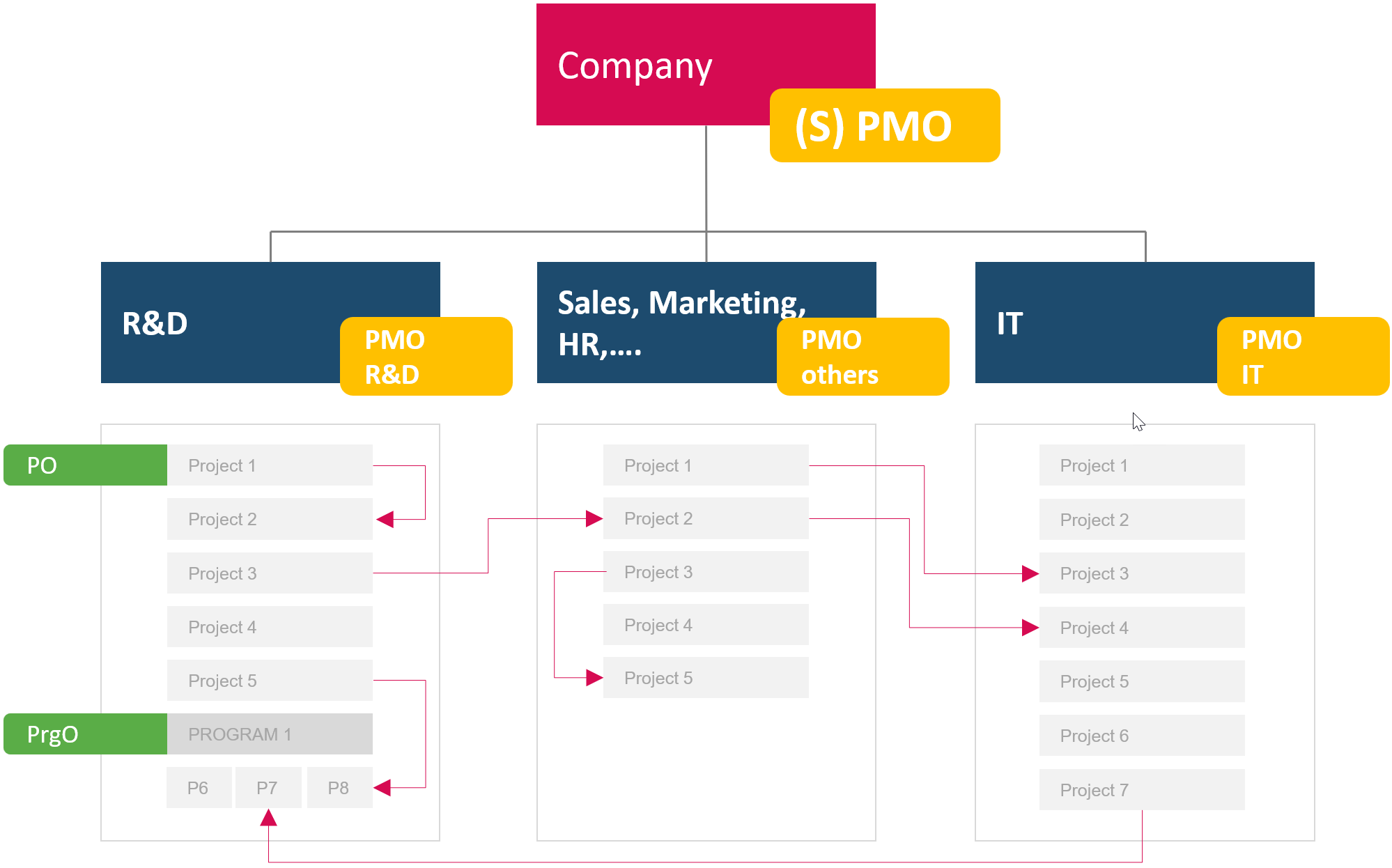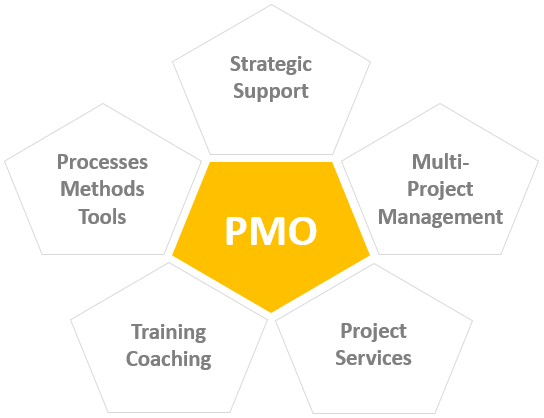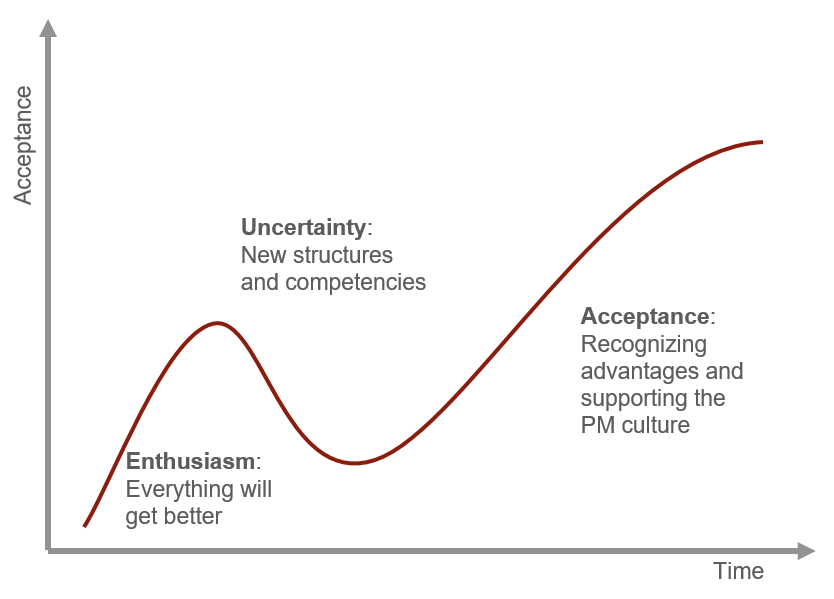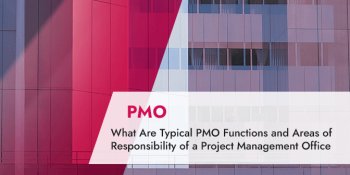What falls under the responsibility of the Project Management Office (PMO)? And what does not? How do you achieve higher PMO acceptance as well as backing from top management? Finally, what are crucial PMO success factors? If you are looking for answers to these questions, this article is just the thing for you.
Whether your PMO is successful, and at what rate, depends on its responsibilities and means. Both must be individually suited to your company and the project management maturity level.
The good news is: despite all differences, there is a range of vital success factors you should know and bear in mind. This article provides these success factors in the form of a checklist. At the end of this article, a bonus is waiting for you: you will get an insight into the findings of the PMO Survey 2020 (Chapter PMO duties). Now, let us get to the list of success factors.
-
- Backing from management
- Organizational position
- Areas of responsibility and competencies
- PMO employee qualifications
- Presenting quick successes
- Recording progress
- Transparency within the company
- Appropriate communication
- Building trust
- Taking one small step at a time
- Insights from PMO Survey – Learn from top performers
- Conclusion and Checklist
Special Download: 10 Vital PMO Success Factors (PDF file)
Please fill in the form.
* Required Fields | Data Protection
1. Backing from Top Management
Every PMO requires a promoter. Only with backing from management and accompanying change management, can your PMO setup be target-oriented.
Three things are vital for your collaboration with top management. They must:
- Understand the venture fully.
- Be convinced of its benefits.
- Actively promote the setup.
With this kind of backing, you will be able to push through unpleasant things – even in critical situations.
PMO Goal and Benefit: Backing from top management smooths the way during setup.
2. Right Position within the Organization
The PMO is a service provider. Its success depends on how happy the stakeholders are in their role as customers. This means you have to involve the stakeholders and their expectations at an early stage. Only then, will you be able to define the right goals.
Another interesting read: Learn about the latest PM Trends
These goals, and the competencies they require, determine the PMO’s position within the organization. It must be a position that allows the PMO to enforce these goals.

What this means: if the PMO has only operational responsibilities, it should have a position close to the department head. If it has strategic responsibilities, it should operate as an executive department of top management.
PMO Goal and Benefit: The right position in the organizational hierarchy provides the necessary weight in the perception.
Special Download: How to setup a PMO in 4 simple steps (PDF file)
Please fill in the form.
* Required Fields | Data Protection
3. Designate Responsibilities and Competencies Clearly
Stakeholders tend to overburden the PMO with tasks. So how can you arrive at a more realistic workload? Formulate a practical and individual mandate, which has been coordinated with all stakeholders. This makes the PMO functions realistic.
PMOs cannot and should not please everybody. They have a designated mandate.

PMO goals and responsibilities aside, it is also important to define what falls outside the PMO’s responsibilities. This makes for clarity and delimits the competencies of the PMO and other organizational units.
What is crucial: communicate clearly, where your responsibilities begin but also where they end!
However, do not draw the wrong conclusions for the collaboration with the project managers. This does not mean the PMO, along with the provided support, will also assume their responsibility!
PMO Goal and Benefit: Clearly defined goals and competencies prevent misunderstandings.
4. Choose Only Qualified PMO Staff
The PMO staff’s qualifications and motivation are of high importance. For instance, the PMO staff must have a certain service mentality. Yet, PMO members also need to be able to say no.
Interested in more detail on PMO implementation? Check out our detailed guide!
You should staff the PMO manager position with a senior employee. This person should have both organizational skills and many years of project management experience.
In addition, you are advised to select individuals with high-level social skills for the responsible positions.
They need to be able to meet seasoned project managers, team leaders, and others in the company, on an equal footing.
PMO Goal and Benefit: Only individuals suited to the job will obtain the necessary acceptance.
Special Download (PDF): What are typical PMO Functions? (+ their importance)
This article provides you with a good comparison as well as ideas for functions you could consider next for your PMO. Please fill in the form to download.
* Required Fields | Data Protection
5. Produce Quick Successes
Establishing a Project Management Office tends to be a politically delicate issue. Hence, you need to report positive changes.
If your PMO manages to produce quick wins at an early stage, this will have a beneficial effect. Stakeholders will be happy that at last someone is addressing issues that have been neglected for too long.
The stakeholders will be open-minded towards the PMO.
A step ahead already? Read this article on the PMO’s future role!
A quick success could be a complete project list, which is also:
- Up to date
- Substantial
- Prioritized (ideally)
This would show all stakeholders what people are actually working on.
PMO Goal and Benefit: Quick, small successes will increase acceptance and create trust.
6. Document Progress Regularly
From the very beginning, you need to scrutinize existing processes in your company’s project management.
You also need to check the effectiveness and efficiency of the tools and methods employed.
Learn more about PMO Tools for Successful Multi-Project Management.
Among others, the form of organization (line / matrix) and the PM training or career field are of consequence in this regard.
These allow you to determine the initial maturity level of your project management in the company. It is vital to document this maturity. What you document will help you demonstrate the improvements you achieved.
It will provide you with important arguments to persuade stakeholders in difficult times.
PMO Goal and Benefit: By demonstrating your progress at regular intervals, you prove the additional value of the PMO.
7. Promote Transparency in the Company
The company culture plays an important part in the success of the new PMO.
It is the task of the PMO to actively cater for transparency in the project environment.
The success of a PMO can also be measured in terms of transparency. How much transparency is actually pursued in the company by all involved? It is common to advocate transparency – but only for others.
Transparency is something you will have to fight for – at least in part. You will find that hardly anyone has an interest in exposing weaknesses in their own area of responsibility.
Especially with respect to resource management, you are likely to encounter resistance.
PMO Goal and Benefit: Increased transparency will expose weaknesses.
8. Ensure Communication between All Parties Involved
One of the PMO’s main responsibilities is to further the efficiency of the company’s project management.
You can achieve this by preparing the regular meetings well. Make a point of informing the right body of people beforehand which decisions will have to be made.
Inform the right body of people beforehand about the decisions that will need to be made. Afterwards, communicate the results you arrived at.
After the meeting, you should make sure that the decisions you made are communicated to all levels. All involved need to find out as soon as possible what has been decided. And how this will affect their work.
Moreover, one of the most important tasks of the PMO is to practice smart self-marketing – “do good and talk about it”.
PMO Goal and Benefit: Good communication makes for a common understanding and a comprehensible approach.
9. Obtain the Trust of the Project Managers
At the outset, the PMO will probably have to face a certain mistrust from the project managers. The latter fear a new supervisory body. They assume the PMO will keep them from operational project management with further administrative tasks.
So, it is important that the PMO builds trust and positions itself as a helper. One thing will soon become clear. The PMO actually increases the time stakeholders can spend with their operational work by:
- optimizing administrative tasks or
- even taking them on altogether.
In addition, the project managers now have a central place of support in all PM matters, tools and training questions.
PMO Goal and Benefit: The right kind of support will create trust and acceptance in all roles involved.
10. Do Not Start with Too Many Areas of Responsibility
Last but not least: see to it that the new PMO can carry out its tasks dependably. So, do not start with too many responsibilities at once.
Check out this article on creating KPIs for the PMO to measure its value.
Stakeholder expectations will be easier to satisfy, which will support acceptance.

At the same time, the organization needs to cope with the changes. Change management should accompany all PMO setup activities.
Looking to advance acceptance? Read about 7 Measures to Increase PMO Acceptance.
Take small, but goal-oriented and successful, steps in the right direction. Do not tackle too many things at once.
In the end, only a PMO functioning in the long run will bring about the desired success.
PMO Goal and Benefit: Extending responsibilities gradually will support acceptance.
Insights from the PMO Survey 2020 – Learn from Top Performers
The PMO Survey 2020 provided important insights with which you should be familiar when determining your own approach. For 330 companies with PMO, TPG determined what the estimated distribution of responsibilities of their PMO was in the year of the survey. Thereafter, we asked the participants to name what distribution of responsibilities they desired for the future.
The bar chart below shows (dark gray bars) that a quarter of the PMOs of all participants are most occupied with Methods / processes / tools as well as the Implementation of projects. Resource management plays the least important part.
In the desired future situation (light gray bars), the responsibilities of Strategic support and Education / training / coaching gain in importance above all. Hence, they are perceived to be increasingly important as are Multi-project and Resource management.

The following chart shows the changes in the distribution of responsibilities by performance level: red = top performer, dark gray = high performer, light gray = low performer.
Across all performance levels, the respondents want to invest less effort into Methods / processes / tools as well as the Implementation of projects.
The successful top performers aim to expand the areas of Education / training / coaching as well as Strategic support the most.

Might this be an important pointer for your priorities in the PMO? Keep these findings in mind when setting up or optimizing your PMO. It might be best to read the whole PMO Survey.
Now, let us take a final look at the 10 vital success factors for a PMO.
Conclusion and Checklist – 10 Vital PMO Success Factors
This article has introduced you to ten fundamental PMO success factors.
With the aid of this checklist, you will be able to prepare the setup of your own PMO. The checklist may also help you increase your project management maturity level in this or that regard by implementing some of the above points.
Our final tips: Get to know the individually adaptable “PPM Paradise” – the optimal environment for your enterprise-wide project, program, portfolio and resource management. Download the eBook now (just click, no form).
And sign up for our bi-weekly blog newsletter to make sure you receive all our updates.
Which of the 10 points do you consider to be most important and why? Please leave your feedback in the comment area below. Thank you so much.
Subscribe to TPG BlogInfo: Never miss new practice-oriented tips & tricks
Every other week: Receive practical tips in TPG blog posts written by recognized experts in project, portfolio, and resource management.
* Required Fields | Data Protection
 Johann Strasser
Johann Strasser
Managing Partner at TPG
The certified engineer, has been a managing partner at TPG The Project Group since 2001. After many years as a development engineer in the automotive and energy sectors, Johann Strasser spent a decade as an independent trainer and consultant in the field of project management. During his tenure, he also served as project manager for software projects in the construction industry and provided scheduling and cost management support for large-scale construction projects. At TPG, he applies his expertise in product development and consulting services for international clients. His special focus is on PMO, project portfolios, hybrid project management, and resource management. For many years now, he has shared his knowledge through presentations, seminars, articles, and webinars.
 Achim Schmidt-Sibeth
Achim Schmidt-Sibeth
Senior Marketing Manager
After earning his engineering degree in environmental technology, he gained many years of experience in project management through his work at an engineering office, an equipment manufacturer, and a multimedia agency. Achim Schmidt-Sibeth and his team have been responsible for marketing and communication at TPG The Project Group for many years now.










4 Comments
Good summary of things to consider when setting up a PMO.
Thank you very much Michael. Which topic of the list is the most important to you?
The key Success of a PMO is the #4, the right person at the right chair, the rest will come with the right staff.
Yazid Boureguaa, thanks for sharing your view! Having the right people in charge of the PMO is indeed indispensable, I agree.